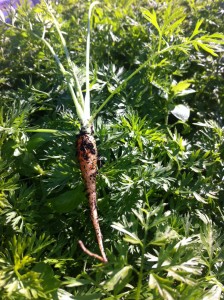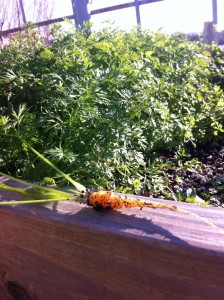I was thinking about cover crops the other day, and suddenly the property owner in me had a realization: cover crops are like tenants. I don’t know if you’ve ever rented property out, but I’m willing to bet that at some point on the arc of your adult life you were a renter. No matter which side of the equation you come from, it’s common sense that great tenants are ones that pay the rent on time and don’t require too much maintenance, and the very best tenants are the ones that do the maintenance for you!
Now it may be hard to find the very best tenants: the ones who definitely change their own lightbulbs (shame on you if you call your landlord for that), paint the apartment attractive colors (not black!), and who can even take care of plumbing leaks with nary a late-night, landlord-come-hither phone call. In the garden world, these would be something like fava beans, which not only laugh at the cold but provide a crop for the gardener (leaves and flowers are yummy and available during the winter) while also doing some heavy-lifting underground in the form of nitrogen fixation (aided, of course, by Rhyzobium bacteria….another sign of a good tenant..nice, helpful friends). Peas are also in this category, offering shoots and tendrils above while grabbing nitrogen below.
But, as we all know, this ain’t no perfect world, so often a good tenant is good enough. At the rooftop garden I have been turning away from “perfect” winter tenants lately, mainly because I want a little more diversity than just legumes, and trying new approaches to cover cropping.
Let’s stop and recall a few of the main functions served by cover crops. First, as their name implies, they cover the soil like a protective blanket. The mere presence of vegetation slows hurtling raindrops and many a soil particle is held in place that would otherwise be winter-washed away. From another viewpoint cover crops could just as well be called banking crops, because they hold within their insoluble tissues the nutrients that would otherwise leach out of the topsoil with winter’s rains or melting snows. When spring comes, they are cut back into the earth and they release their deposit. As I mentioned before, some crops, like legumes, give interest on the deposit in the form of extra nitrogen, which they are said to have “fixed” from the air. Generally, whether nitro fixers or not, cover crops are for the garden, not for the gardener’s enjoyment. Hands off the cover crop….it’s for the soil! Period, end of conversation…that’s sound garden doctrine.
But the astute reader will have already caught me in a little heresy. If I’m willing to take a few shoots, leaves, and flowers from my peas and favas, supposedly a hands-off cover crop, who knows where I’ll draw the line as to my garden orthodoxy. Just so it’s all on the table, here’s my slightly iconoclastic take on cover crops. For larger plots and certainly for farm-scale ventures, the cost of fertilizer and compost can be prohibitive (never mind the labor cost of spreading them), so it makes sense to grow cover crops that benefit the soil only and that have no marketable end. A little restraint (as in watching a crop grow, but not getting to eat or market it) for one or two seasons gets you bountiful yields for the rest of the year But in the small-scale urban world, every bit of garden real estate is precious, and gardeners generally want to get their teeth on all that their plot yields, not merely watch it grow untouchable produce. Besides, in the world of small gardens, fertilizer and compost costs are not outrageous, and it may make more sense to grow the heck out of the garden year-round and just supplement with outside nutrients when necessary.
That’s why this season, I am trying to do just that with Merida carrots, an overwintering carrot offered by our local seed company, Territorial Seed Company, out of Cottage Grove, Oregon.
http://www.territorialseed.com/product/Merida_Conventional_and_Organic_Carrot_Seed/carrot_seed
Normally no one thinks of carrots as cover crops, but at the very least, they do satisfy the minimum definition: they store nutrients in their tissues and protect the soil. Still, I’m looking for a harvest here, so I’m running counter to my fellow gardeners’ thoughts this time of year.
Merida is a carrot that has been developed for the winter season. It’s intended to be planted during September and October and then harvested in May or June. Its growth window, happily, coincides with our need to keep the soil covered, so I’m calling Merida our newest cover crop. Clearly, come spring, we will be eating some of the nutrients the crop stored, and so those little molecules will not make it back to the soil to nourish future crops, but we will compost the greens and thus recycle some nutrition back to the garden. Plus if I eat garden-grown carrots then go back and work in the garden, it may be said that the energy of that carrot went back into the garden, right?
My September-planted Meridas are looking on pace to size up beautifully in spring. Last week, before a cold snap descended upon us and froze the soil, I pulled a couple nice ones out for observation and made sure I thinned up the rest for good winter growth.
Alright, so carrots don’t fix nitrogen from the air and they do use up nutrients from the soil, but when I think of how sweet it will be to pull up nice, hefty carrots in May, and when I think of how these carrots will have protected the soil through the worst of our winter weather, I get to thinking maybe these Meridas are not just good but pretty excellent tenants after all.

![images[1]](http://www.urban-ag-solutions.com/wp-content/uploads/2015/12/images1.jpg)

